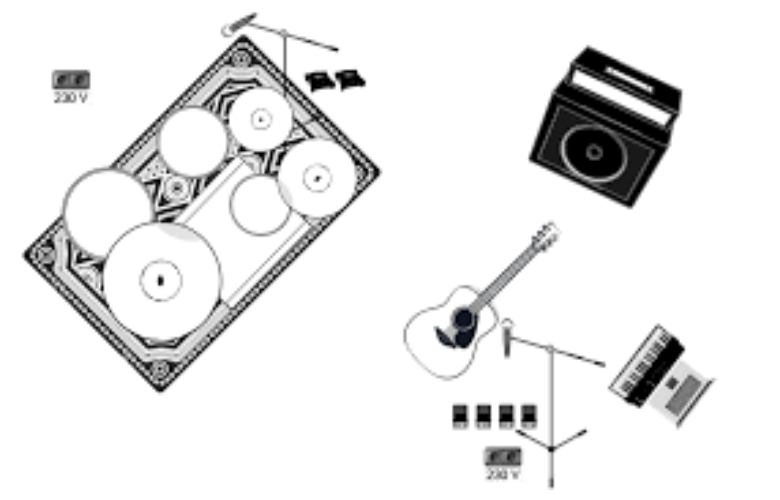
How to read a stage plot is something one learns from almost their first day on the job in the industry. A stage plot is a day-to-day occurrence for anyone who works within music venues. These documents often depict bands and performers of various types on the stage and what they will need to make the show happen on that stage. For some bands, it is as simple as a basic drum kit set up, a D.I. (direct input) box for their keyboard, another D.I. for the guitar play, and enough microphones to cover anyone doing vocals. When you start getting into the major leagues however, stage plots can often require more. The opposite can sometimes be said for performers just starting out in the industry.
As those who are just starting out performing live or touring and getting a thrill of life on the road, a stage plot sometimes hasn’t even crossed their mind. It’s one of those think ahead details that not many people outside of the industry really think about. More frequently than we would like to admit, we often get emailed a stage plot that looks something along the lines of this:
This is still a relatively well labelled stage plot but there are also so many things missing. The band has clearly given everyone’s name which can help with identifying people when they arrive for the set up and rehearsal. The filled in black boxes are nine out of ten times going to be the band’s monitors. The keyboard play and acoustic guitar play both need D.I. boxes, which means direct input boxes. The acoustic guitar player, lead guitar player, and bass guitar player all have blue dots in front of them, which by their stage plot indicates all three of them will need vocal microphones. For the majority of bands, this means your standard SM58. The bass and guitar amps are further back towards the drummer with the guitar amp having an instrument microphone in front of it. Again, for the majority of bands, this will mean your standard SM57 or SL57. The drums are listed as a five piece kit and they will likely be asked to be on a raised stage or have a rug underneath their kit if it’s an outdoor stage. Be prepared for both if possible. The last thing you might hear from the band is something being grumbled about how this isn’t their most up to date stage plot.
The stage plot for All American Rejects back in 2012 for their United Kingdom and European tour looked like this:
For anyone who has recently seen the band they know their set up doesn’t look anything remotely similar to that now. As the stage plot clearly shows however, everything is labelled as it should be. The dimensions with the black lines typically indicate legs (curtains hiding parts of the stage from the audience). Their drum kit is clearly on a raised separate piece of stage deck along with the keys and spare drum parts. Pedal boards are in front of the guitarists to switch between effects easily. Monitor beach is where the band’s I.E.M.s (also known as In Ear Monitors) would be getting mixed by their monitor engineer. They also have power labelled so the venue crew know how much power and how many lines they’ll need. While The All American Rejects stage plot may no longer look like this, it is still a great example to go by for any live band who is touring.


Janine has always been a part of music and performing. The first show that inspired her to go into theatre was the Velveteen Rabbit which she saw as a child, and Drew works to keep that magic alive in her work. When Drew was accepted into an internship program for audio engineering at a recording studio, she jumped at the opportunity. That was at the start of 2020, and so much has happened since then, both in her career and in the world. Since then, Drew has taken several opportunities to work at recording studios, concerts, festivals, and even large theatres while spending some time on tour. Drew's favorite by far though, has been the chance to work on Broadways and West End shows, as this was a dream come true. Drew is honoured to get to share these experiences from being inside the entertainment industry.
Read Full Profile© 2021 TheatreArtLife. All rights reserved.

Thank you so much for reading, but you have now reached your free article limit for this month.
Our contributors are currently writing more articles for you to enjoy.
To keep reading, all you have to do is become a subscriber and then you can read unlimited articles anytime.
Your investment will help us continue to ignite connections across the globe in live entertainment and build this community for industry professionals.